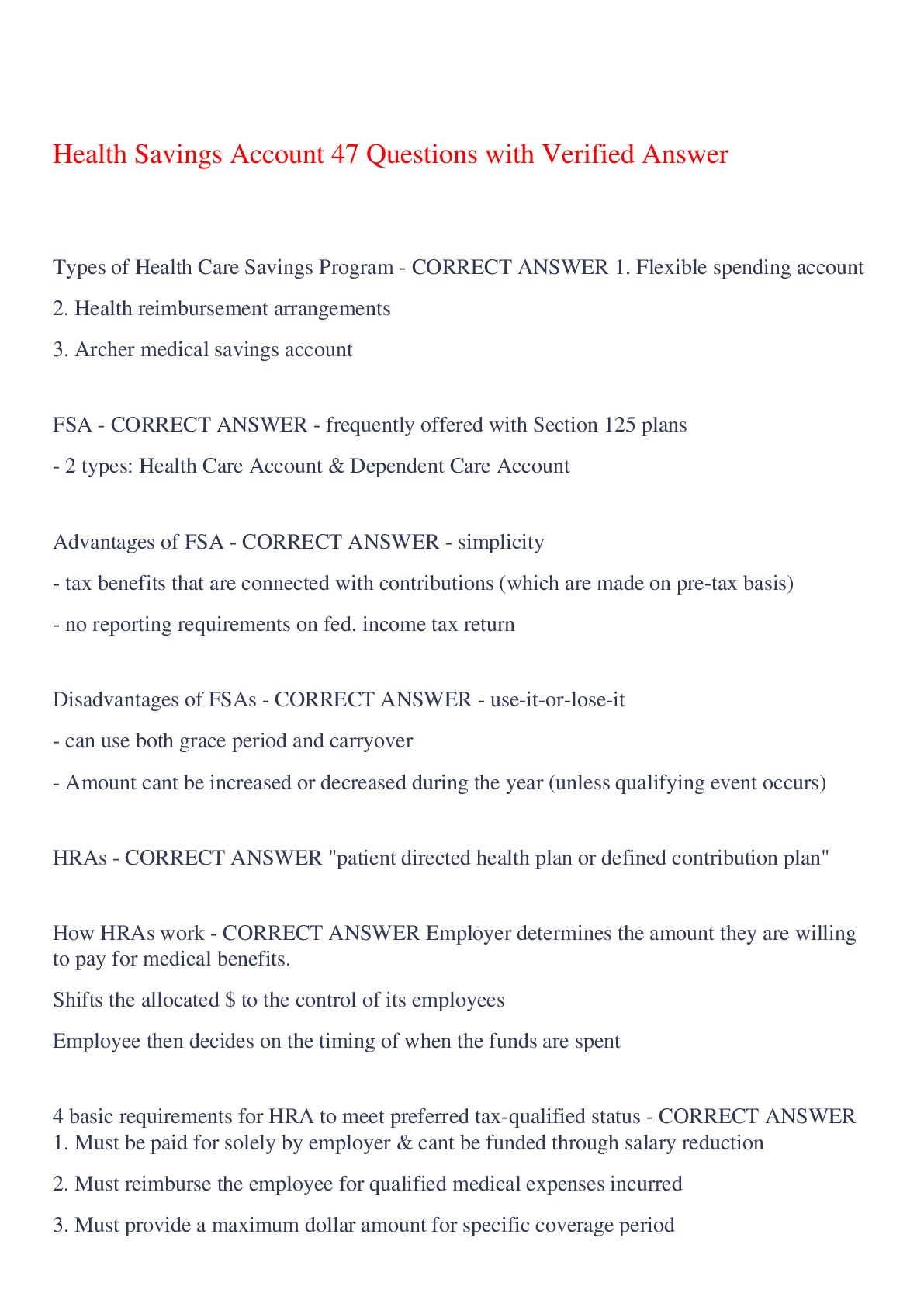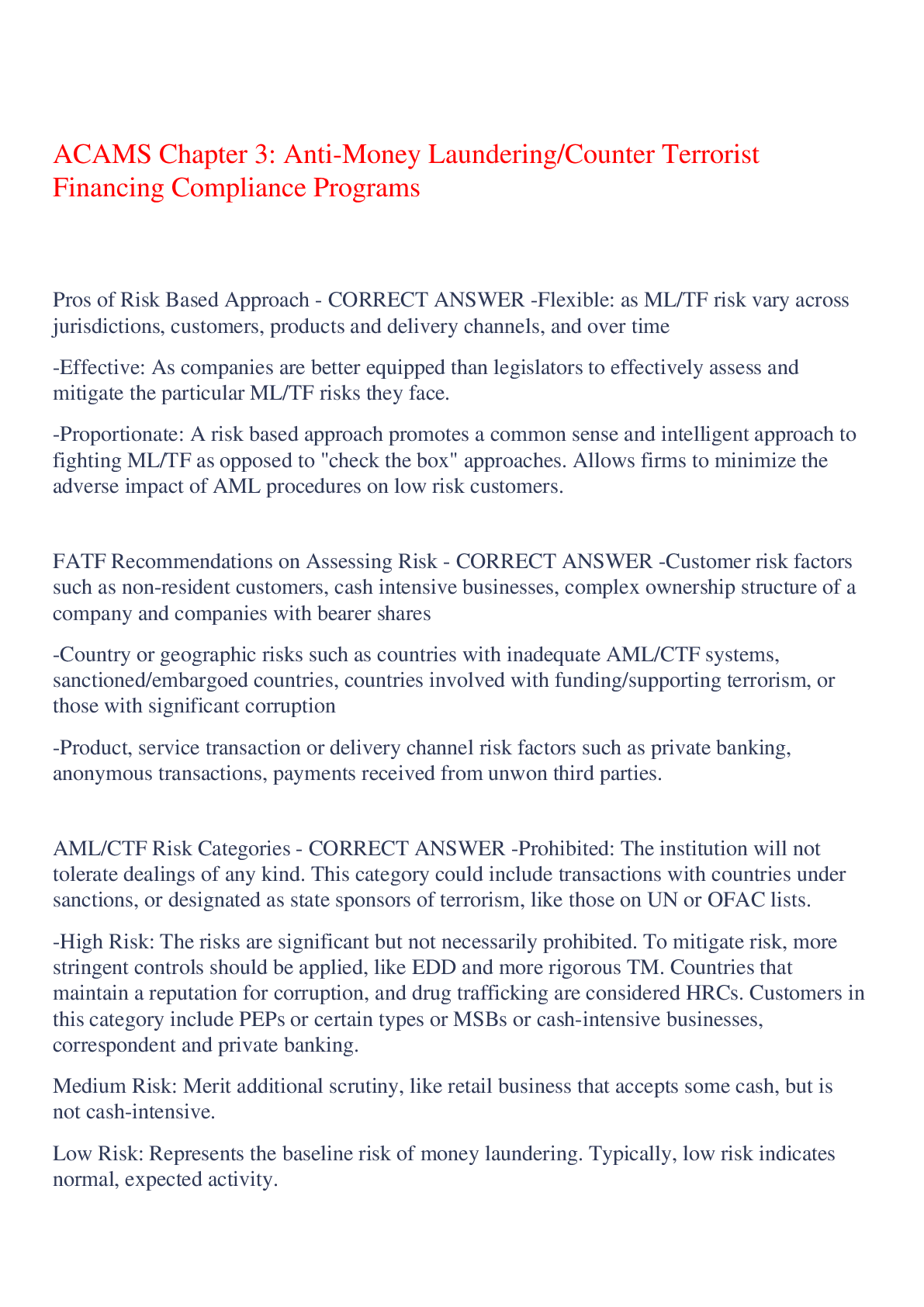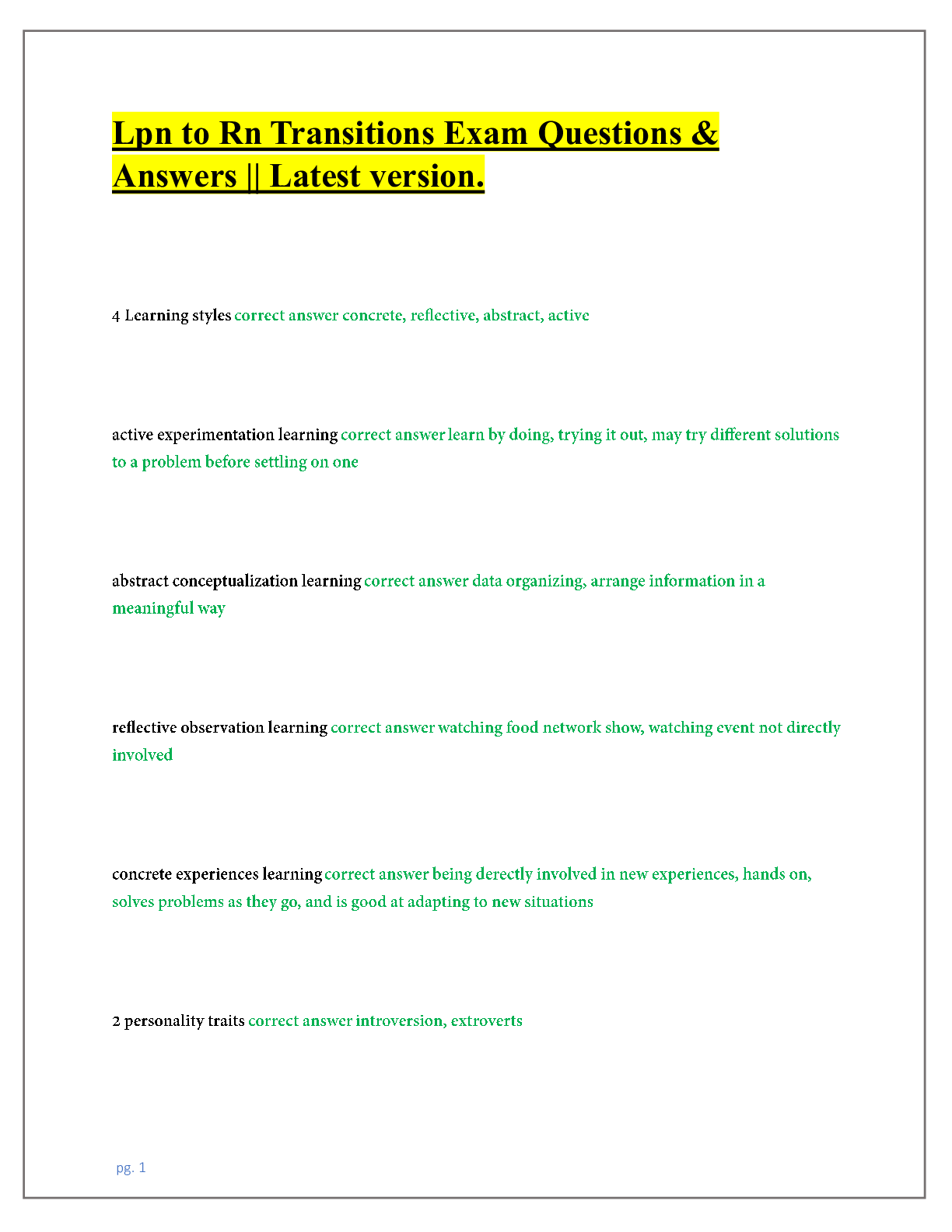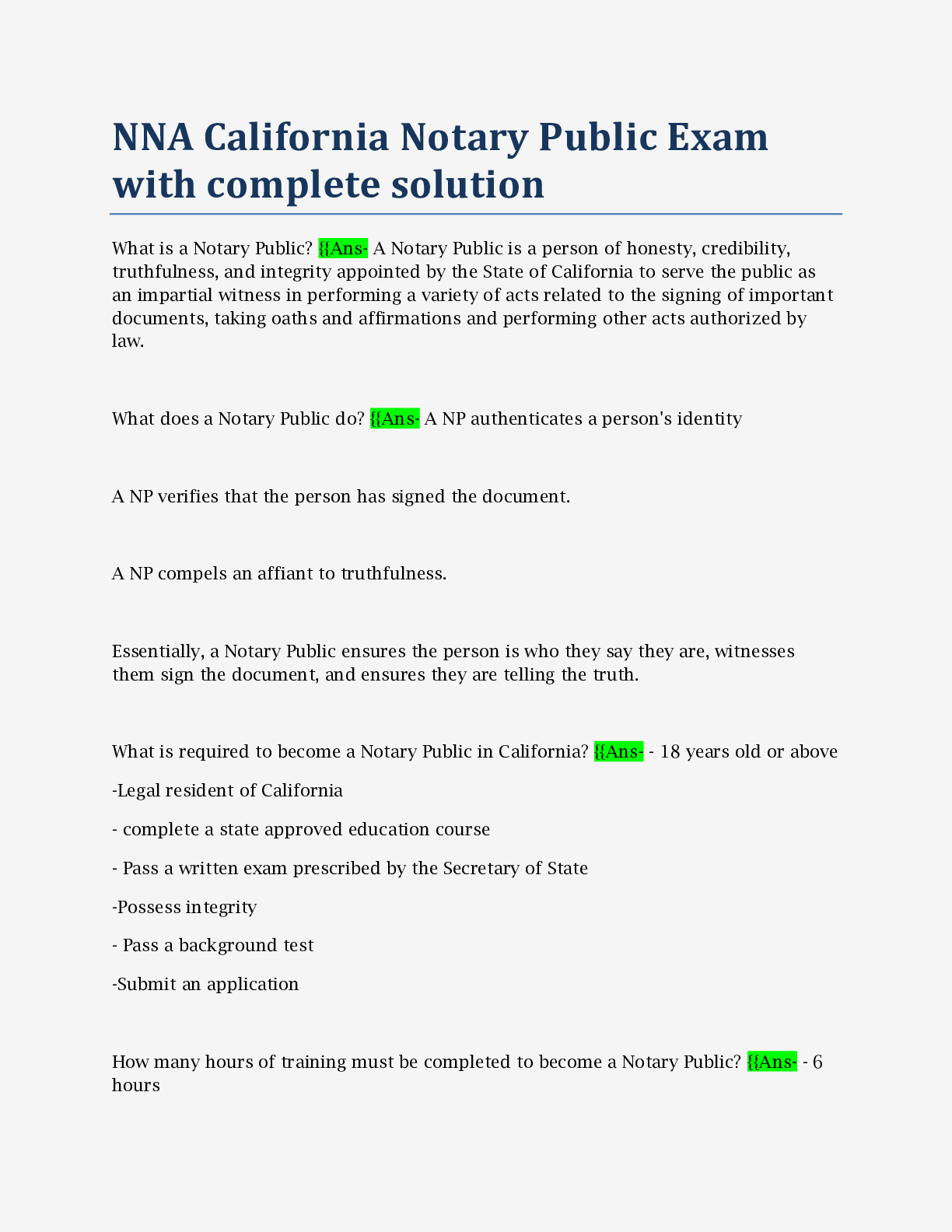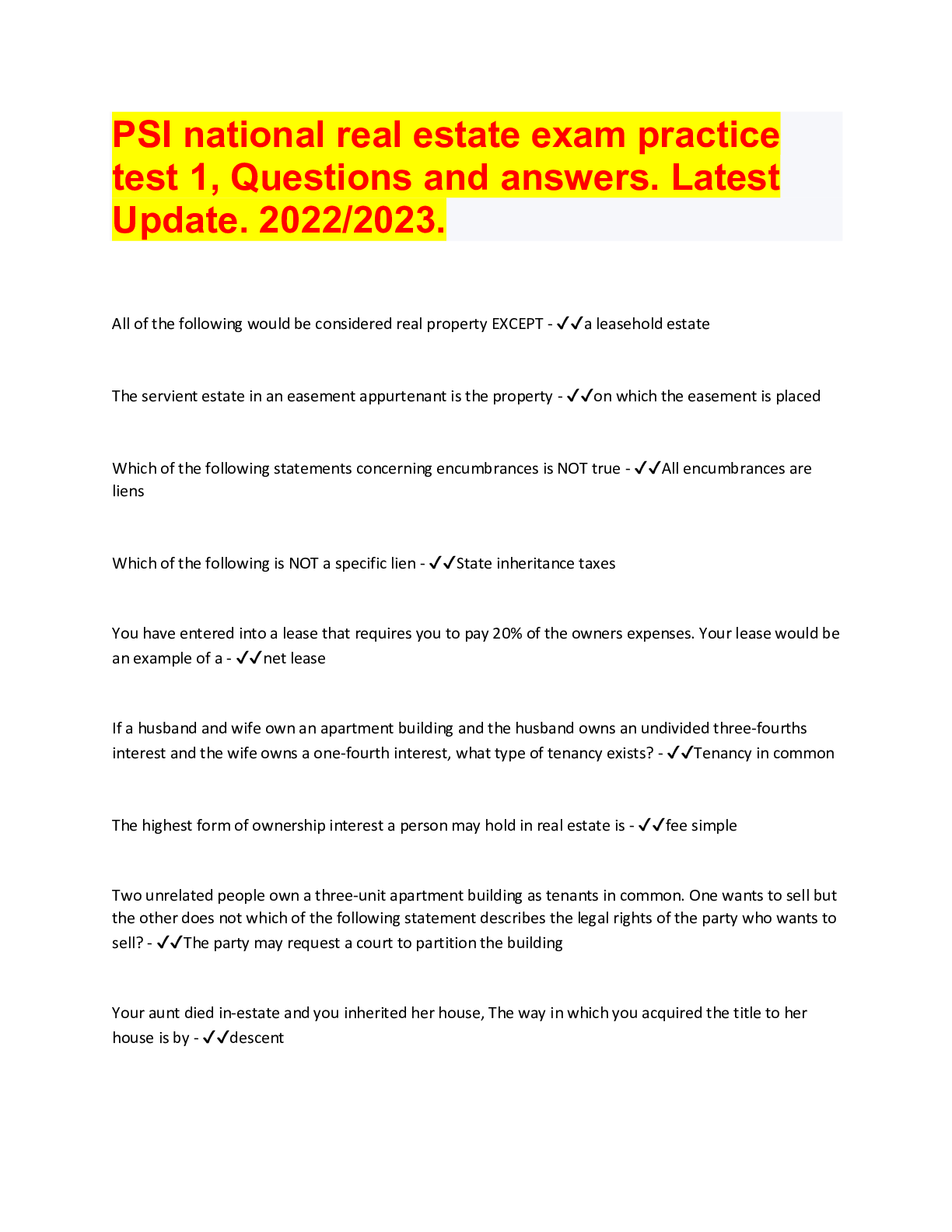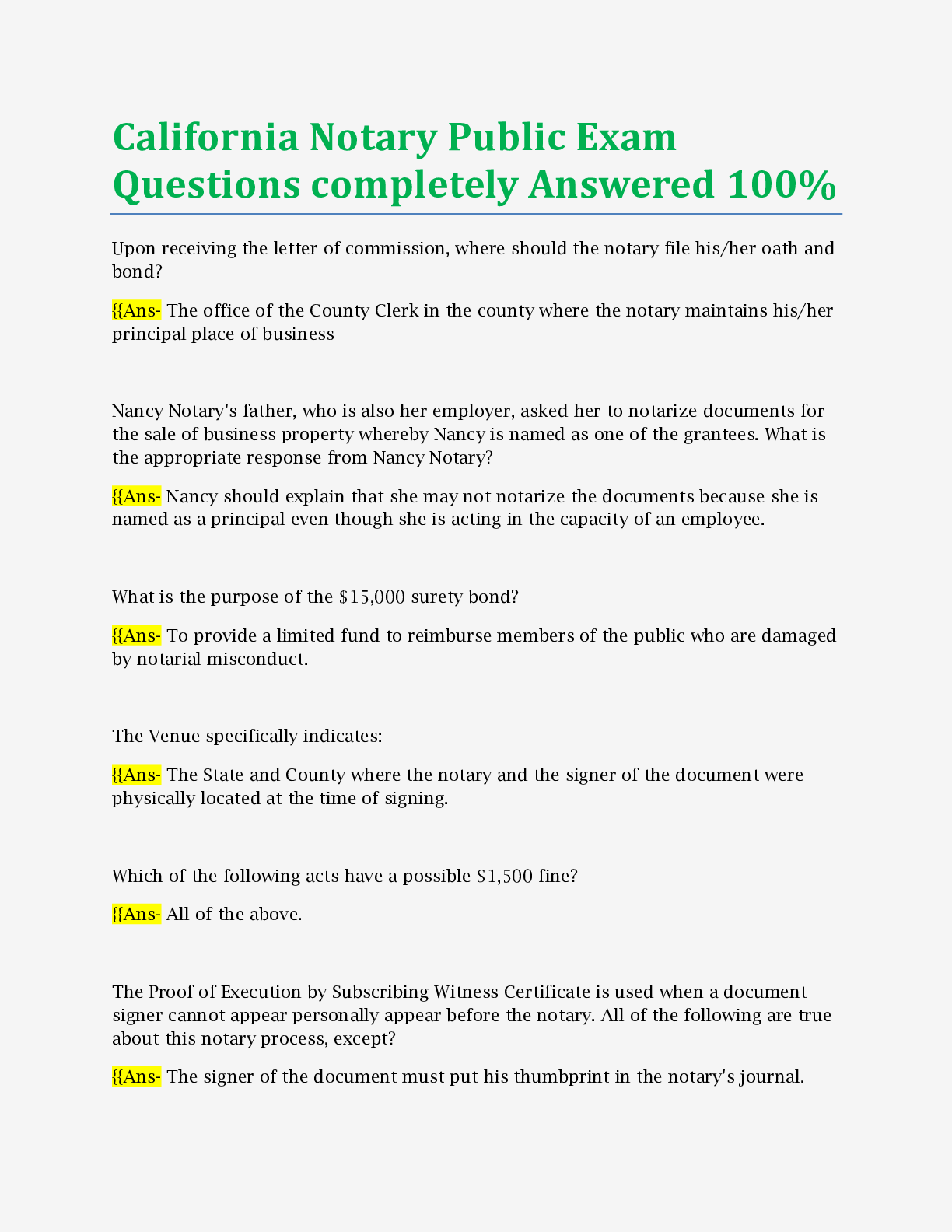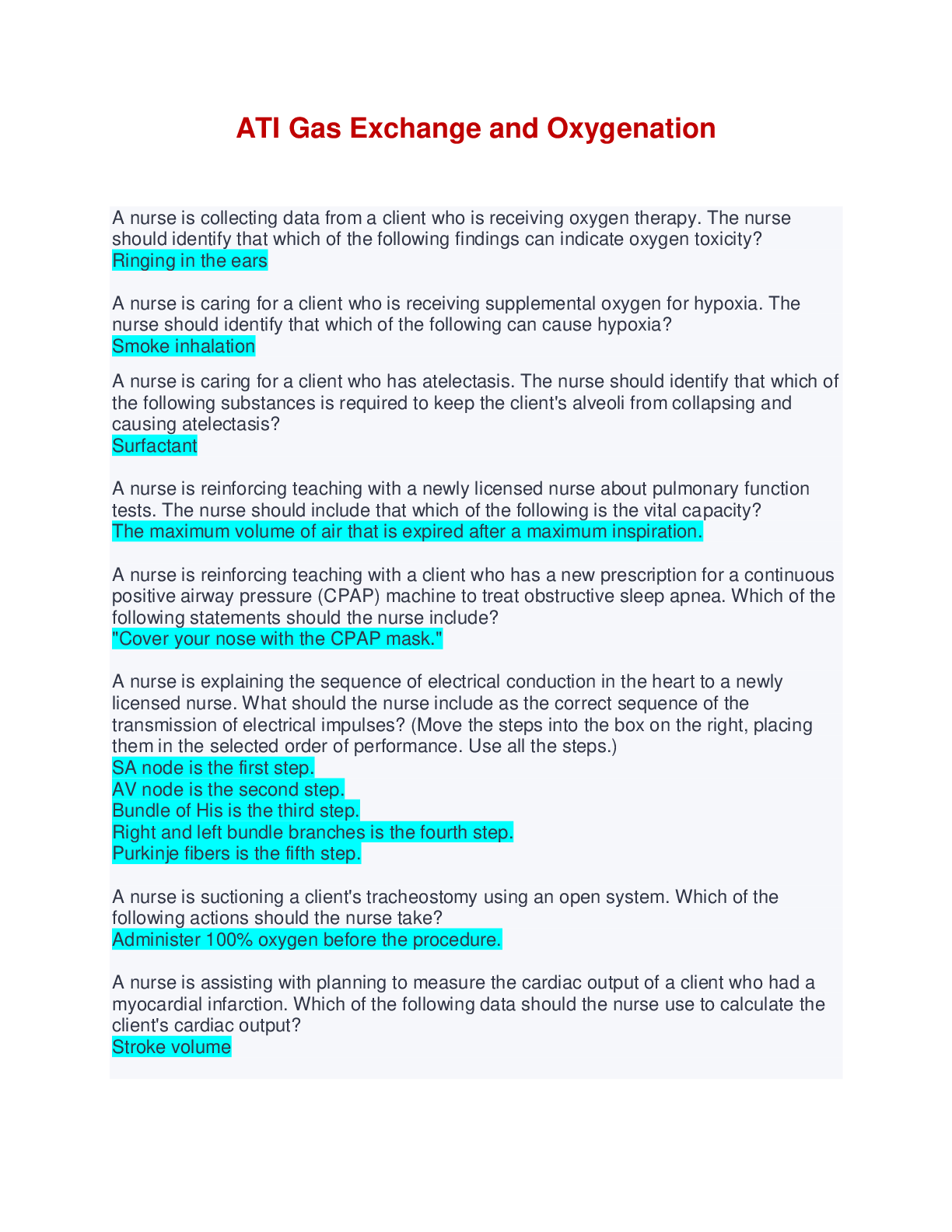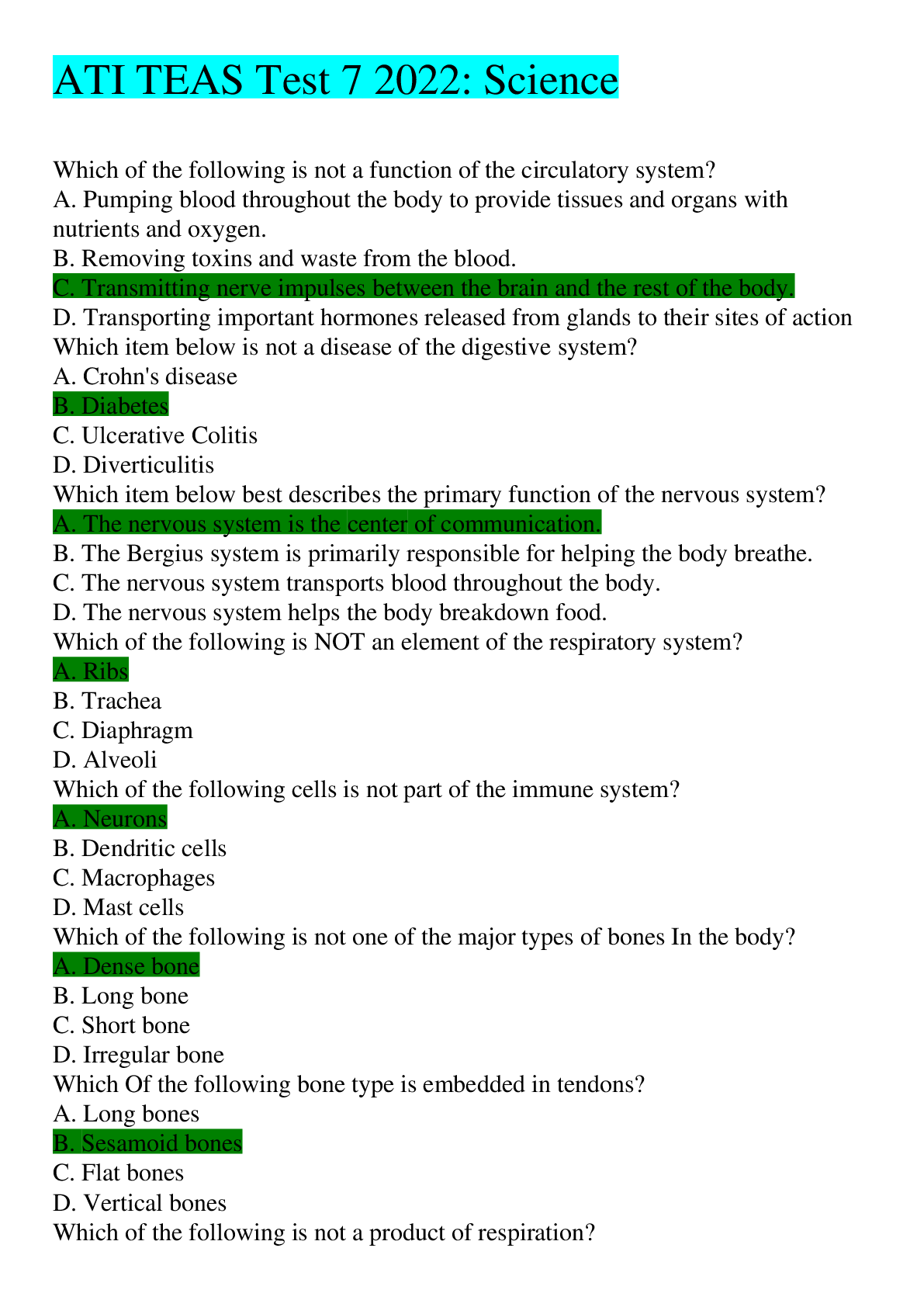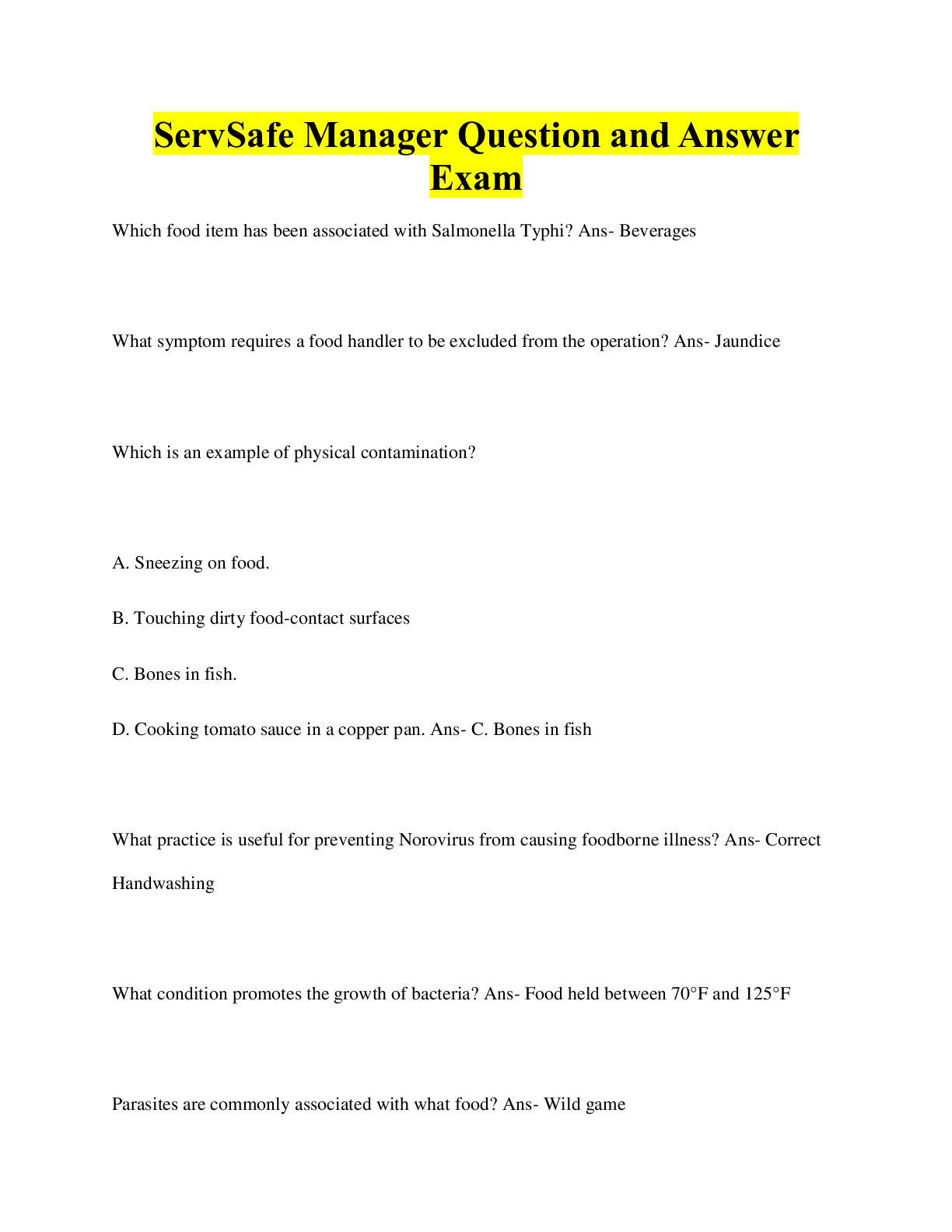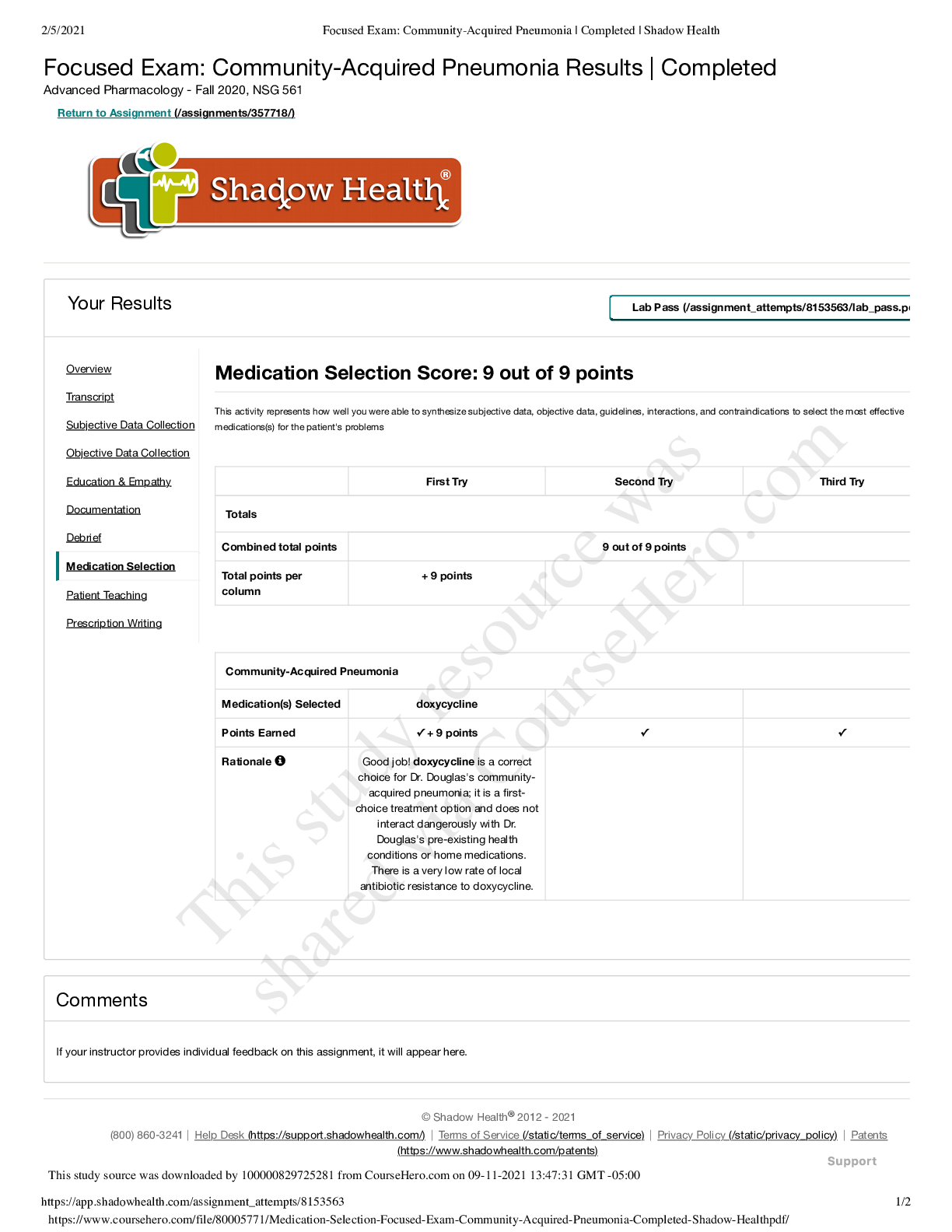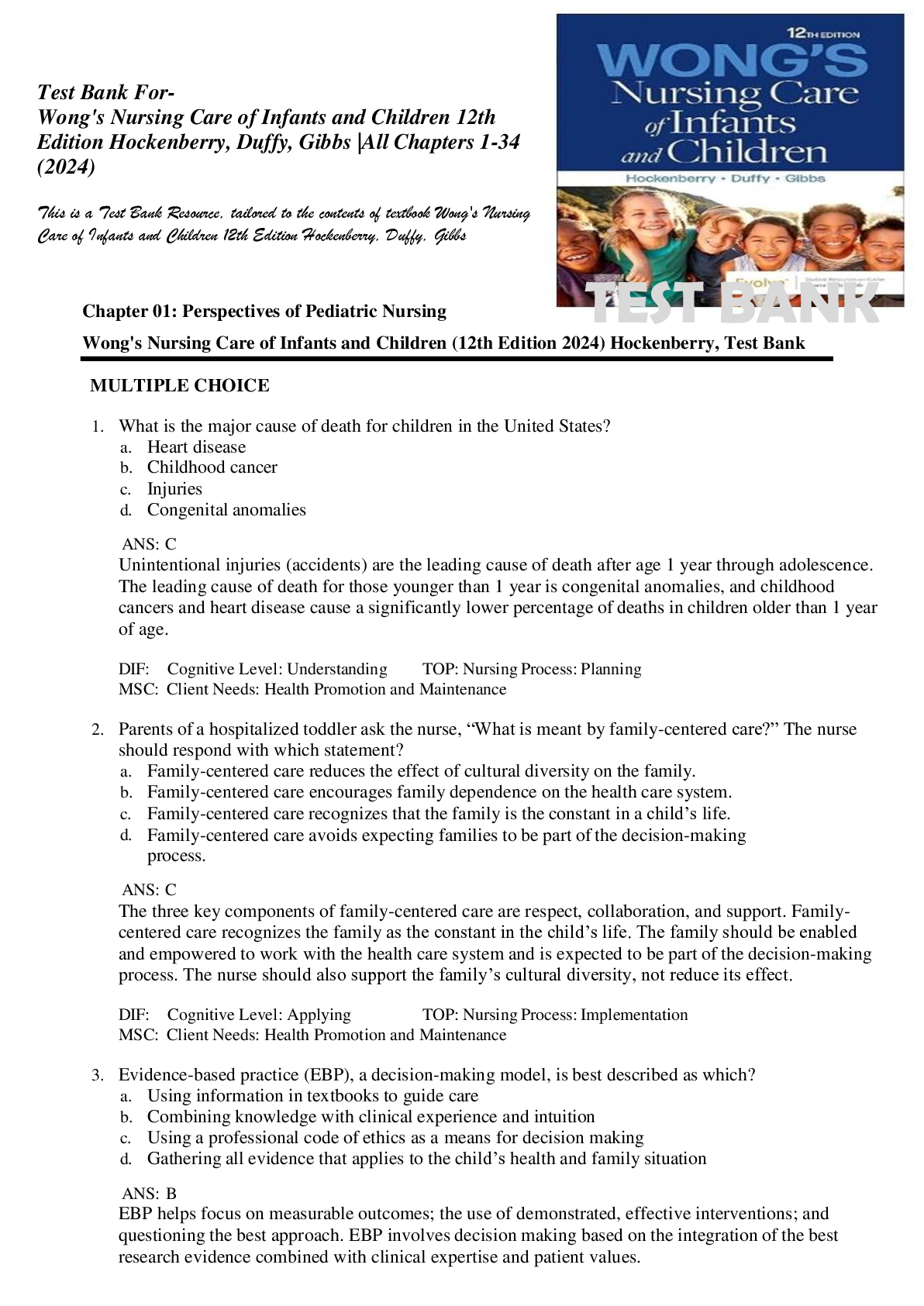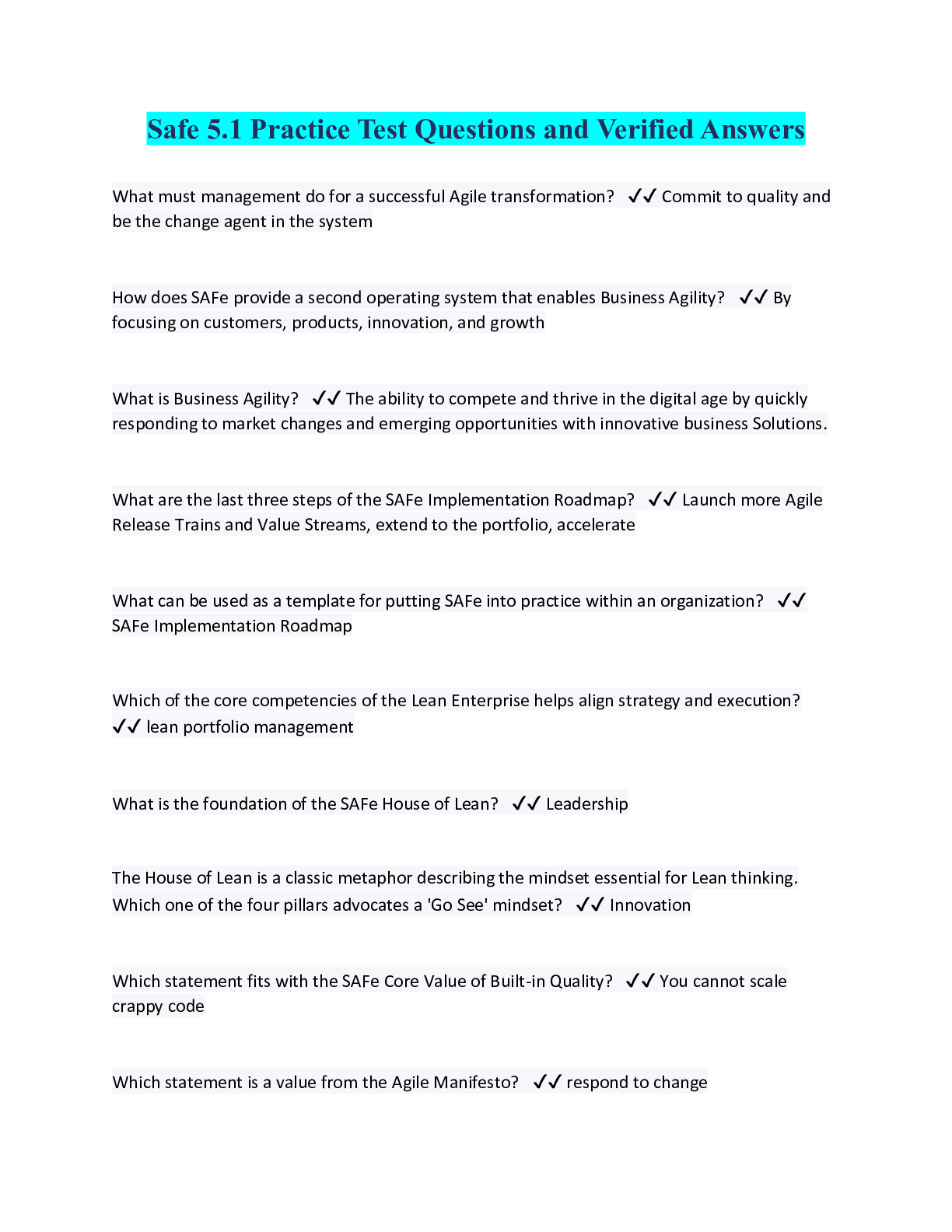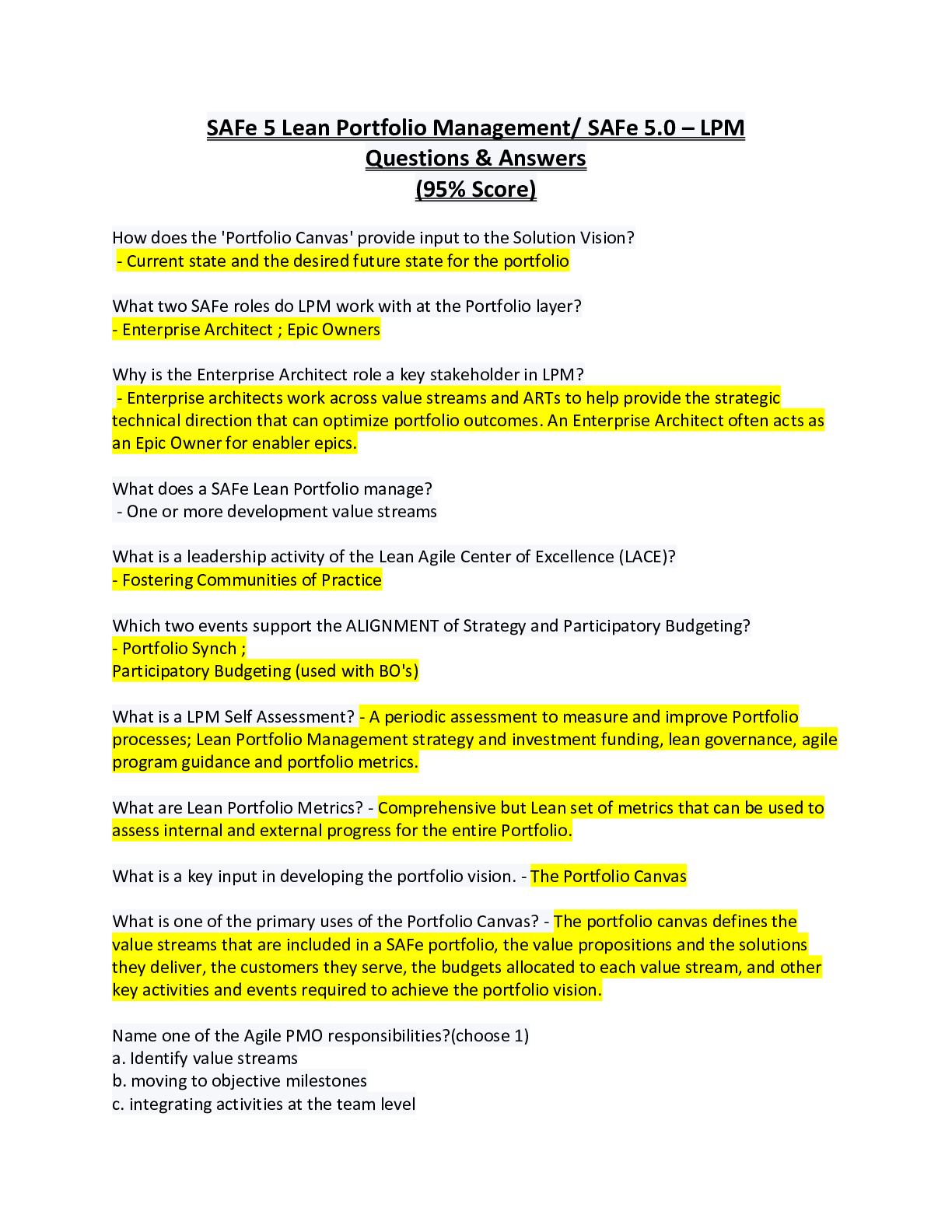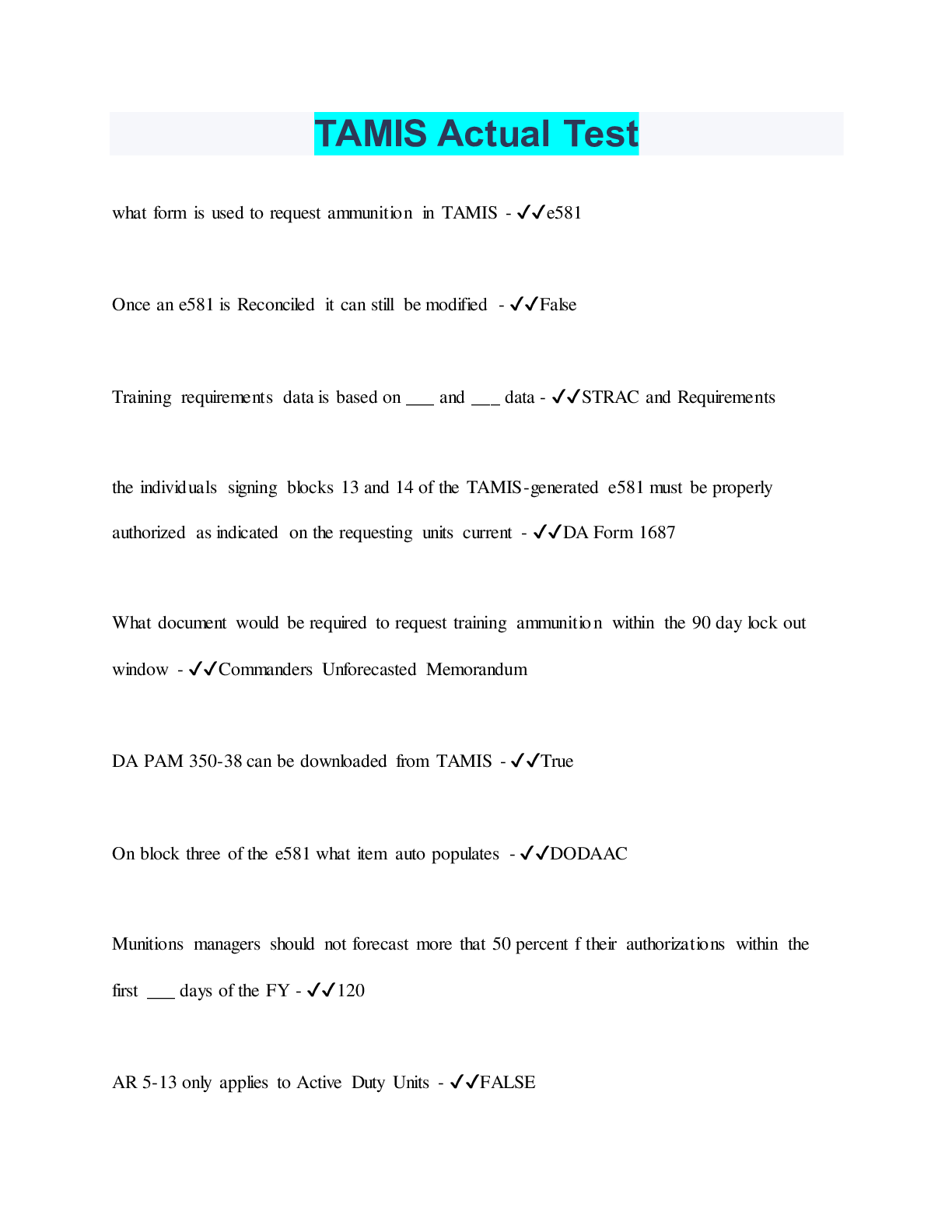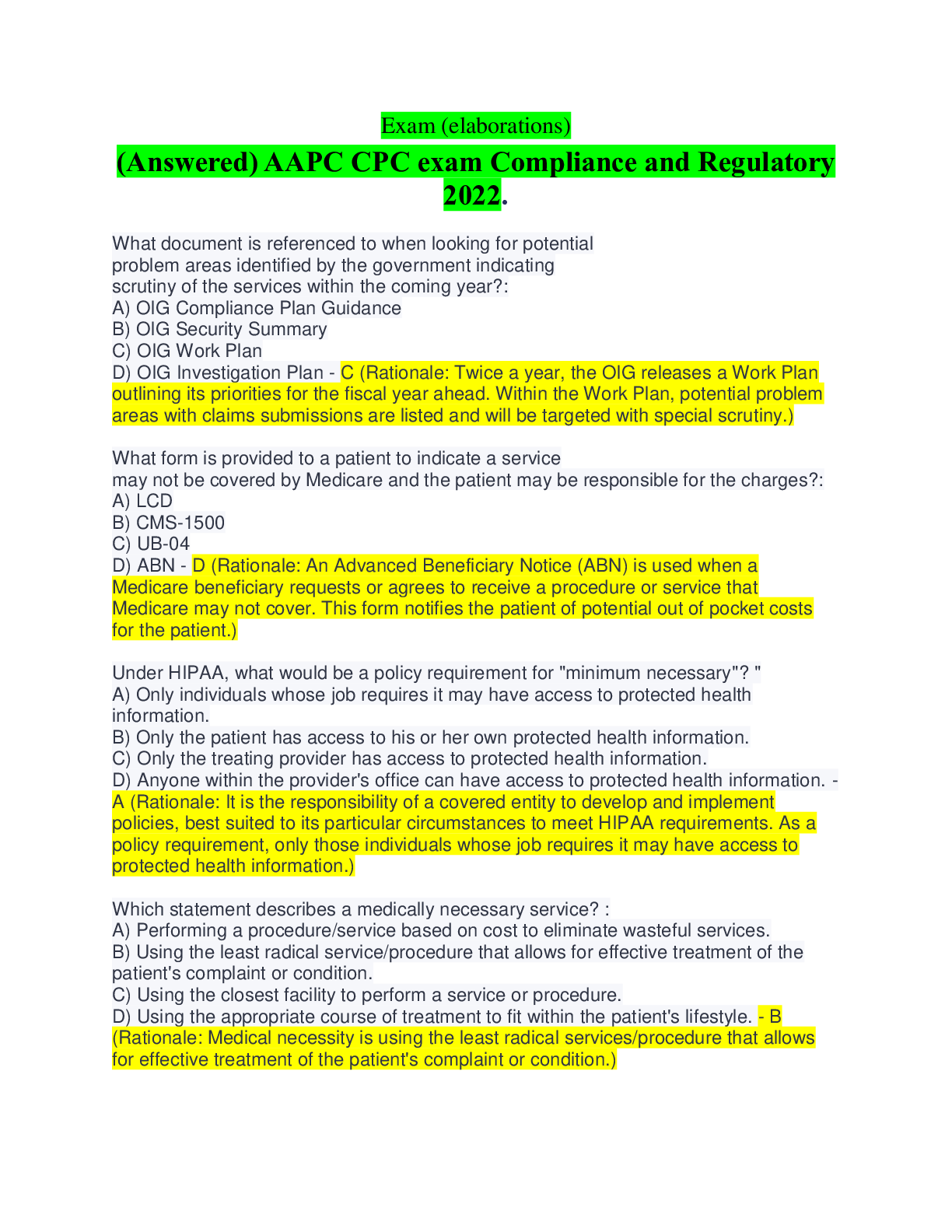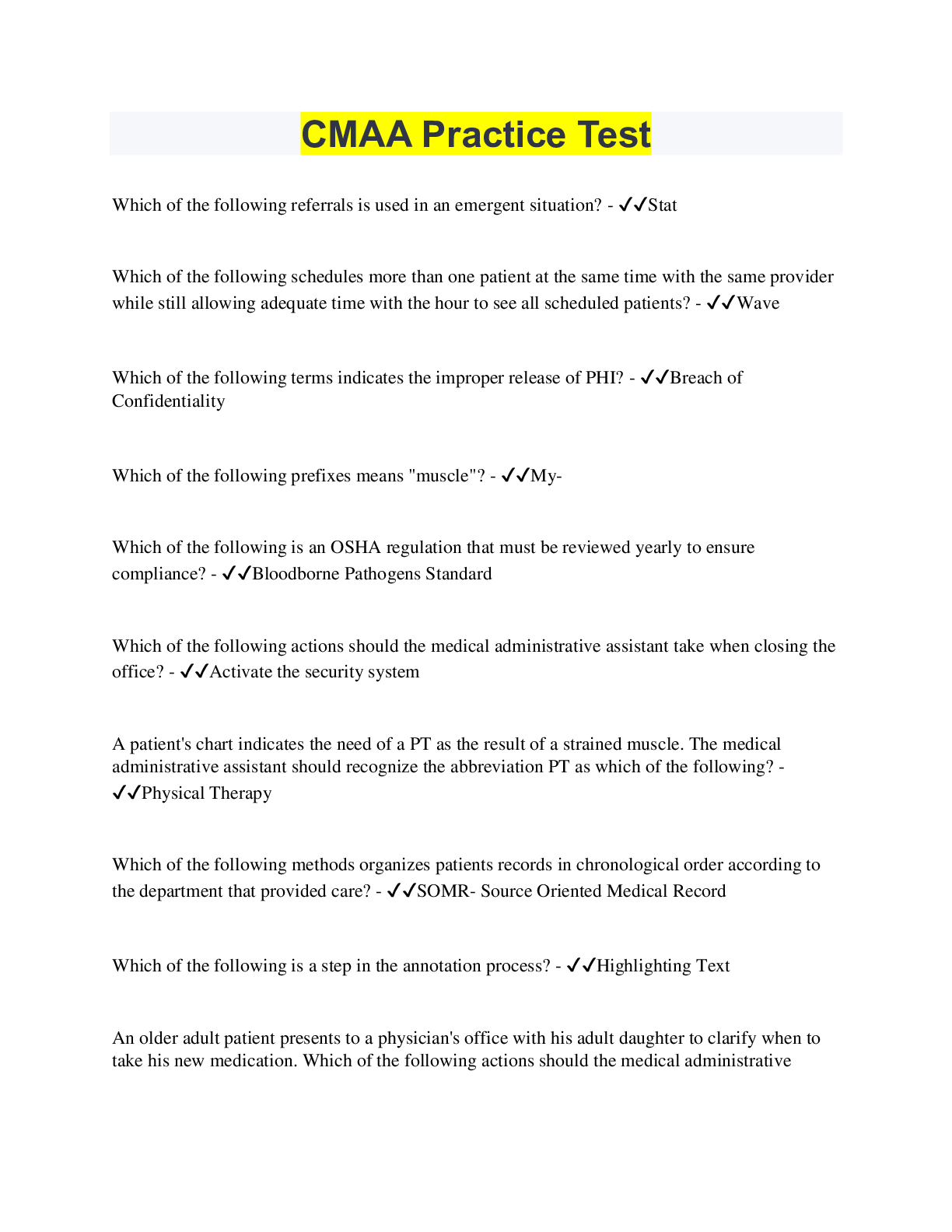Business > EXAM > ACAMS Chapter 3: Anti-Money Laundering/Counter Terrorist Financing Compliance Programs,100% CORRECT (All)
ACAMS Chapter 3: Anti-Money Laundering/Counter Terrorist Financing Compliance Programs,100% CORRECT
Document Content and Description Below
ACAMS Chapter 3: Anti-Money Laundering/Counter Terrorist Financing Compliance Programs Pros of Risk Based Approach - CORRECT ANSWER -Flexible: as ML/TF risk vary across jurisdictions, customers, ... products and delivery channels, and over time -Effective: As companies are better equipped than legislators to effectively assess and mitigate the particular ML/TF risks they face. -Proportionate: A risk based approach promotes a common sense and intelligent approach to fighting ML/TF as opposed to "check the box" approaches. Allows firms to minimize the adverse impact of AML procedures on low risk customers. FATF Recommendations on Assessing Risk - CORRECT ANSWER -Customer risk factors such as non-resident customers, cash intensive businesses, complex ownership structure of a company and companies with bearer shares -Country or geographic risks such as countries with inadequate AML/CTF systems, sanctioned/embargoed countries, countries involved with funding/supporting terrorism, or those with significant corruption -Product, service transaction or delivery channel risk factors such as private banking, anonymous transactions, payments received from unwon third parties. AML/CTF Risk Categories - CORRECT ANSWER -Prohibited: The institution will not tolerate dealings of any kind. This category could include transactions with countries under sanctions, or designated as state sponsors of terrorism, like those on UN or OFAC lists. -High Risk: The risks are significant but not necessarily prohibited. To mitigate risk, more stringent controls should be applied, like EDD and more rigorous TM. Countries that maintain a reputation for corruption, and drug trafficking are considered HRCs. Customers in this category include PEPs or certain types or MSBs or cash-intensive businesses, correspondent and private banking. Medium Risk: Merit additional scrutiny, like retail business that accepts some cash, but is not cash-intensive. Low Risk: Represents the baseline risk of money laundering. Typically, low risk indicates normal, expected activity. AML/CTF Risk Scoring - CORRECT ANSWER Numeric values used to determine the category of risk (geography, customer type, products/services) as well as overall customer risk. Scores for each category are combined for a composite score. Factors can be weighed differently. Degree of complexity is up to discretion of the institution. The next step is to determine the thresholds to establish for each risk category. It is important to periodically reassess risk rating criteria. High Risk Customer Types - CORRECT ANSWER -Banks -Casinos -Offshore corps or banks in tax/banking havens -Embassies -MSBs -Virtual Currency Exchanges -Car, boat and plane dealerships -Use car truck dealers and machine parts manufacturers -professional service providers (attorneys, accountants, investment brokers, etc) -Travel agencies -Broker/dealers in securities -jewel, gem and precious metals dealers -import/export companies -cash intensive businesses Products/Services Risks - CORRECT ANSWER Does a new or current service: -Enable significant volume of transactions to occur rapidly? -allow the customer to engage in transactions with minimal oversight? -afford significant anonymity to users? -have an especially high transaction or investment value? -allow payments to third parties? -have unusual complexity? -require government verification of customer eligibility? High Risk Products/Functions - CORRECT ANSWER -Private banking -offshore international activity -deposit taking facilities -wire transfer and cash management functions -transactions in which the primary beneficiary is undisclosed -loan guarantee schemes -travelers checks -official bank checks -money orders -foreign exchange transactions -international remittances -payments services like payment processors, prepaid products, ACH -remote deposit capture -trade financing transactions with unusual pricing features -payable through accounts Basic Elements of an AML/CFT program - CORRECT ANSWER -A system of internal policies, procedures and controls (first line of defense) -A designated compliance function with a compliance officer (second line of defense) -An ongoing employee training program -An independent audit function to test the overall effectiveness of the AML program (third line of defense) Risk Based Procedures for CDD - CORRECT ANSWER -Understanding the nature and purpose of customer relationships for the purpose of developing a customer risk profile -Conducting ongoing monitoring to identify and report suspicious transactions -Maintaining and updating customer information. AML Policies, Procedures and Controls should: - CORRECT ANSWER -Identify high risk operations; provide for periodic updates to the institution's risk profile; and provide AML/CFT program tailored to manage risks -Inform the board of directors and senior management of compliances initiatives, known compliance deficiencies, STRs filed and corrective action taken -Devleop and maintain a system of metrics reporting that provides accurate and timely information on the status of the AML/CFT program, including stats on key elements of the program, like transactions monitored, alerts generated, cases created ands STRs filed. -Assign clear accountability to persons for performance of duties under the AML/CFT program -provide for program continuity despite changes in management or employee compensation or structure -meet all regulatory requirements and recommendations for AML/CFT compliance -Provide for periodic review and timely updates to implement changes in regulations (at least annually) -Implement risk based CDD policies, procedures and processes -Provide for dual controls and segregation of duties -comply with all record keeping requirements, including retention and retrieval of records -provide sufficient controls and monitoring systems for the timely detection and reporting of potentially suspicious activity and large transaction reporting. Also should include procedure for recording dismissal reasons -Establish clear accountability lines and responsibilities to ensure appropriate oversight. -Establish training requirements and standards to ensure employers are made aware of and have understanding of procedures and their importance/relevance. -Clearly explain importance of reporting suspicious activity -incorporate into all job descriptions and performance review processes the requirement to comply at all times. -Develop and implement screen ing programs to ensure high standards when hiring. -Develop and implement quality assurance testing programs to test effectiveness of program and execution of its requirements. Elements of Policies - CORRECT ANSWER -Clear and simple high level statements that are uniform across the entire organization -Approved by executive management or board of directors -Reflects the high level responsibilities of the stakeholders through-out the organization Elements of Procedures - CORRECT ANSWER -Translates the AML/CFT policies into an acceptable and workable practice, tasking stakeholders with their respective responsibilities -May be established at the operational (not executive) level of the institution. -Much more detailed than policies -Reviewed and updated regularly Elements of Controls - CORRECT ANSWER -The internal technology or tools the institution uses to ensure the program is functioning as intended and within predefined parameters -Alerts compliance to potential outliers or deviations from normal policy that may need to be reviewed. -Includes management reports, automated review systems, or the utilization of multiple reviewers Compliance Function - CORRECT ANSWER Commonly referred to as the second line of defense. Responsible for monitoring the controls of the business. Must be established in manner that it can fulfill its role effectively. Complexity of the function should be based on the nature, size, regulatory environment and risk associated with the institution. Program Management - CORRECT ANSWER -Manages and coordinates regulatory examinations -Performs periodic reviews and updates of the program -Coordinates implementation activities with lines of business and groups to ensure applicable procedures get update to incorporate program changes -Monitors regulatory environment for changes -May be involved in preparing training materials and providing guidance and advice on more complicated AML/CFT matters. KYC - CORRECT ANSWER -Assigns a risk code to all clients based on CDD risk assessment score -Performs additional due diligence on medium and high risk clients identified via the CDD process or clients seeking certain products/services -Provides a first line of contact of business questions on AML/CFT matters Sanctions Screening - CORRECT ANSWER -Manages sanctions screening software applications or processes -Monitors and reconciles data being received from the source systems -Fine tunes the filter thresholds in accordance with changes in the risk profile of the organization -Reviews suspected matches and reports valid matches to the appropriate regulatory authorities. Transaction Monitoring - CORRECT ANSWER -Manages transaction monitoring software applications -Monitors and reconciles data being received from source systems -Fine-tunes the filter thresholds in accordance with changes in the risk profile of the organization -Participates in the design of transaction monitoring typologies and maintains the extensive documentation required Financial Investigations - CORRECT ANSWER -Monitors alerts generated on customer transactions, such as those from automated systems and referrals from line of business staff -Investigates such alerts and referrals, and files STRs with the appropriate FIU as required. Components of an Effective AML/CFT Training Program - CORRECT ANSWER -Explain the relevant AML/CFT laws and regulations -Cover the institutions policies and procedures to mitigate risk. Who to Train - CORRECT ANSWER -Customer Facing Staff -Operations personnel -AML/CFT compliance staff -Independent testing staff -Senior management and board of directors What to Train On - CORRECT ANSWER -General background and history of AML/CFT -Legal framework -Penalties for violations -Internal polices (like CDD and EDD) -Review of internal AML/CFT and sanctions risk assessments -Legal recordkeeping requirements -Suspicious transaction monitoring and reporting requirements -Currency transaction reporting requirements -How to react when faced with a suspicious client or transaction -How to respond to customer who want to circumvent reporting requirements -Duties and accountability of employees -Maintaining confidentiality -AML trends and emerging issues -Real life ML schemes, including red flags, impact on institution and its ultimate resolution. How to Train - CORRECT ANSWER -Identify issues to be communicated and best way to disseminate message -Identify audience by functional area and level of employee. -Determines needs that should be addressed -Determine who can best develop and present the training -Determine if "train the trainer" sessions are necessary, where decentralized training is involved -Create a course abstract or curriculum that addresses, goals, objectives and desired results. -As much as possible, establish a training calendar that identifies topics and frequency of each course -Consider whether to provide handouts -Tests should be considered as an evaluation of how well training is understood -Attention span should be considered -Track attendance Independent audit - CORRECT ANSWER Should: -Assess the overall integrity and effective of AML/CFT program, including policies, procedures and processes -Asses the adequacy of the AML/CFT risk assessment -Examine the adequacy of CDD policies, procedures and processes and whether they comply with regulatory requirements -Determine personnel adherence to the institution's AML/CFT policies, procedures and processes -Perform appropriate transaction testing, with emphasis on high risk operations -Assess training adequacy -Assess compliance with applicable laws and regulations based on appropriate jurisdictions -Examine the integrity and accuracy of management information systems used in the AML/CFT compliance program. -Review all the aspects of any AMl/CFT compliance functions that have been outsourced to third parties -Evaluate the ability fo transaction monitoring software application to identify unusual activity -Review case management and STR systems -Assess the effectiveness of the institution's policy for reviewing accounts that generate multiple STR filings. -Assess the adequacy of recordkeeping and record retention processes -Track previously identified deficiencies and ensure management corrects them promptly -Decide whether the audit's coverage and frequency is appropriate for the institution's risk profile -In coordination with board, ensure the overall audit coverage and frequency are appropriate -consider whether the board of directors was responsive to earlier audit findings FinCEN guidelines for strengthen compliance culture in financial institutions - CORRECT ANSWER 1. Leadership must actively support and understand compliance efforts 2. Efforts to manage and mitigate AML/CFT deficiencies and risk must not be compromised by revenue interests 3. Relevant information from various departments within the organization must be shared with compliance staff to further AML/CFT efforts 4. The institution must devote adequate resources to its compliance function 5. The compliance program must be effective. 6. Leadership and staff must understand the purpose of its AML/CFT efforts and how its STR reporting is used. Final Rule - CORRECT ANSWER Issued by NY State Department of Financial Services in 2016, requiring regulated institutions to maintain "Transaction Monitoring and Filtering Programs" reasonably designed to: -Monitor transactions after their execution for compliance with BSA/AML laws. -Prevent unlawful transactions with targets of economic sanctions administered by OFAC -Requires boards of directors or senior officers of institutions to make annual certifications confirming they have taken all steps necessary to comply with the above. 8 Minimum requirements for the Transaction Monitoring and Filtering Program - CORRECT ANSWER 1. Identification of all data sources 2. Validation of the integrity, accuracy and quality of data 3. Data extraction and loading processes to ensure a complete and accurate transfer of data 4. Governance and management oversight 5. Vendor selection process if a thirty party is used 6. Funding to design, implement and maintain a program 7. Qualified personnel or outside consultant 8. Periodic training FATF recommendations for CDD measures - CORRECT ANSWER -FATF Recommends CDD be undertaken when: -Establishing business relationships -Carrying out occasional transactions under certain circumstances -There is suspicion of money laundering or TF -The financial institution has doubts about the veracity or adequacy of previously obtained customer identification data Main Elements of a CDD program - CORRECT ANSWER FATF recommends institutions incorporate the following into their CDD programs: -Identifying the customer and verifying their identify using reliable independent sources -Identifying beneficial owner and taking reasonable measures to verify their identity -Understanding and when appropriate, obtaining information on the purpose and intended nature of the business relationship -Conducting ongoing due diligence on the business relationship and scrutiny of transactions undertaken throughout the course of the relationship to ensure that the transactions being conducted are consistent with the customer profile. Customer Identification (CDD) - CORRECT ANSWER Full ID of customer and business entities, including source of funds and wealth when appropriate. Institutions should ensure there is a process to update and maintain current client info. Profiles (CDD) - CORRECT ANSWER Development of transaction and activity profiles for each customer. Profiles should contain sufficient information to allow for reviews of anticipated versus actual account activity to be able to compare to knowledge of customer Customer Acceptance (CDD) - CORRECT ANSWER Definition and acceptance of the customer in the context of their use of specific products and services. Risk rating (CDD) - CORRECT ANSWER Assessment and grading of risks presented by the customer's account relationship. Numerous factors should be considered (i.e. client type, products services, transactional activity, and geography). No single factor (except sanctions) should determine risk. Monitoring (CDD) - CORRECT ANSWER Account and transaction monitoring based on the risks presented Investigation (CDD) - CORRECT ANSWER Investigation and examination of unusual customer or account activity, should be consistent with anticipated activity for the type of client. Documentation (CDD) - CORRECT ANSWER Documentation of findings as evidence or to provide a record of actions performed. Risk factors for EDD - CORRECT ANSWER -Customer risk factors -Country or geographic risk factors -Product, service, transaction or delivery channel risk factors Additional EDD information for high-risk customers - CORRECT ANSWER -Source of funds/wealth -Identifying info on individuals with control over the account, like guarantors or signatories -occupation/type of business -financial statements -banking references -domicile -proximity of the customer's residence, employment, or business to the bank -description of the customer's primary trade area and whether int'l activity is normal -description of the business operations, volume of currency and total sales anticipated, a list of major customers and suppliers -explanations for changes in account activity. Requirements for natural clients opening accounts - CORRECT ANSWER -Legal name, and any other names used -Complete residential addresses, and dependent on risk, also the business address or post office number -Landline or mobile telephone numbers and email address -Date and place of birth and gender -Nationality and residency status -Occupation and employer -An official personal ID number -Type of account and nature of banking relationship -Signature Document verification - CORRECT ANSWER -Confirming the identity from an unexpired official document that has a photograph -Confirming the date and place of birth from an official document -Confirming the validity of the official documentation through certification by an authorized person -Confirming the residential address Non documentary verification procedures include: - CORRECT ANSWER -Contacting customer by phone or letter to confirm info supplied after account creation -Checking references provided by other institutions -Using an independent information verification process Requirements for foreign clients or entities opening accounts - CORRECT ANSWER -Name, legal form status, proof of incorporation -permanent adress -mailing and registered address -Identity of natural persons authorized to operate the account, or the identity of relevant person who is a senior managing official -Contact phone numbers -Official ID number -Powers that regulate and bind legal person -Identity of beneficial owner -Financial situation of entity -Expected use of the account Targeted Sanctions - CORRECT ANSWER Aimed at specifically named individuals, i.e. key leaders in a country, named terrorists, significant narcotics traffickers, proliferation of weapons. Often include asset freezing and travel bans. Sectoral Sanctions - CORRECT ANSWER Aimed at key sectors of an economy to prohibit a very specific subset of financial dealings within those sectors to impeded future growth. Comprehensive Sanctions - CORRECT ANSWER Generally prohibit all direct or indirect import/export, trade brokering, financing or facilitating against most goods, technology or services. These are often aimed at regimes responsible for gross human rights violations and nuclear proliferation UN Article 41 - CORRECT ANSWER Sanctions measures emcompassed under the article are a broad range of enforcement options that do not involve the use of armed force. EU Article 215 of the Treaty on the Functioning of the EU - CORRECT ANSWER Provides a legal basis for the interruption or reduction, in part or entirely, of the EU's economic and financial relations with one or more countries outside the EU, where such restrictive measures are necessary to achieve the objectives of the Common Foreign and Security Policy. Specially Designated Nationals and Blocked Persons list - CORRECT ANSWER Published by OFAC, the SDN list contains thousands or names of individuals and businesses, as well as aircraft, ships from more than 150 countries that the US government considers to be terrorists, international narcotics traffickers, and others covered by US sanctions. Know Your Employee (KYE) - CORRECT ANSWER A KYE program is one that the institution has to understand an employee's background, conflicts of interest, and susceptibility to ML complicity. Automated AML/CFT solutions - CORRECT ANSWER -Automated customer verification -Watch list filtering -Transaction monitoring -Automation of regulatory reporting -Case management -Audit trail Capabilities of Automated system to assess - CORRECT ANSWER -Ability to monitor transactions and identify anomalies -Ability to gather CDD information for new and existing, score customer responses and store CDD data -Ability to conduct advanced evaluation and analysis of suspicious/unusual transactions identified by the monitoring system in the context of each client's risk profile -Ability to view individual alerts within broader context of clients total activity -Workflow features, -Ability to use data from the institutions's core customer and transaction systems and databases to inform/update monitoring and case management -Ability to store and recall at least 1 year's data -Ability to manage the assignment, routing, approval and ongoing monitoring of investigations -Automated preparation and filing of STRs to the FIU -Standard and ad-hoc report on the nature/volume of investigations and investigator productivity for management and other audiences -Enhanced ability to plan, assign and monitor the caseload per employee of AML-related investigations -Ability to provide comprehensive and accurate reporting -User friendly updating of risk parameter settings -Tiered user rights access for users, managers and auditors Unusual Customer Behavior Red Flags - CORRECT ANSWER -Customer has an unusual or excessively nervous demeanor -Customer discusses a financial institution's recordkeeping or reporting requirements with the apparent intention of avoiding them -Customer threatens employee in an effort to discourage reporting/recordkeeping -Customer is reluctant to proceed with transaction after being told it must be reported -Customer suggests paying a gratuity to an employee -Customer, who is a PEP, opens an account in the name of family member who begins making large deposits not consistent with known sources of income -Customer, who is a student, uncharacteristically transfers or exchanges large sums of money -Account shows high velocity movement of funds, but maintains low beginning or ending balances. -Transaction involves offshore institutions whose names resemble those of well known legitimate financial institutions -Transaction involves unfamiliar countries or islands that are hard to find on an atlas or map -Agent, attorney or financial advisor acts for another person without proper documentation, such as a power of attorney Unusual Customer ID Circumstances - CORRECT ANSWER -Customer furnishes unusual or suspicious identification documents or declines to produce originals for verification -Customer is unwilling to provide personal background information -Customer tries to open an account without ID, references or a complete local address -Customer's permanent address is outside of the institution's service area -Customer's home or business telephone is disconnected -Customer does not wish a statement of his account or any mail sent to them -Customer asks lots of questions about how the institution disseminates information about ID of the customers -A business customer is reluctant to provide complete information about the nature an purpose of its business, anticipated account activity, and other details about the business or to provide financial statements or documents about a related business entity -Customer provides no record of past or present employment on a loan application -Customer's IP address does not match the identifying information provided during online registration Unusual Cash Transactions - CORRECT ANSWER -Customer makes large cash deposit without having counted the cash -Customer frequently exchanges small bills for large bills -Customer's cash deposits often contain counterfeit bills or musty or extremely dirty bills -Customer comes in with another customer and they go to different tellers to conduct currency transactions under the reporting threshold -Customer makes large cash deposits containing many larger denomination bills. -Customer opens several accounts in one or more names, then makes several cash deposits under the threshold -Customer withdraws cash in amounts under reporting threshold -Customer withdraws cash from one account and deposits into another account held by them -Customer conducts unusual cash transactions through night deposit boxes, especially large sums that are not consistent with known business -Customer makes frequent deposits or withdrawals of large amounts of currency for no apparent business purpose or for a business that is not cash intensive -Conducts large cash transactions at different branches on the same day, or coordinates others to do on their behalf -Deposits cash into several accounts below the threshold and then consolidates funds into one account and transfers them abroad -Customer attempts to take back a portion of a cash deposit that exceeds the threshold after learning about the CTR -Customer conducts several deposits below threshold at ATMs -Corporate account has deposits or withdrawals primarily in cash -Customer frequently deposits large sums of cash wrapped in currency straps -Customer makes frequent purchases of monetary instruments with cash in amounts less than the reporting threshold -Customer conducts an unusual number of foreign currency exchange transactions -Customer conducts Forex and currency swaps without caring about margins -Non-customer deposits cash into a customer account, which was subsequently withdrawn in a different geographic location Unusual non-cash deposits - CORRECT ANSWER -Customer deposits a large number of traveler's checks -Customer deposits large numbers of consecutively numbered money orders -Customer deposits checks and/or money orders that are not consistent with the stated purpose of account or nature of business -Customer deposits a large number of third party checks -Funds deposited are moved quickly out the account via payment methods inconsistent with the established purpose of the account. Unusual wire transfer transactions - CORRECT ANSWER - Wire transfers are sent/received from the same person to or from different accounts -Non-accountholder sends wire transfer with funds that include numerous monetary instruments, each in an amount under the threshold -An incoming wire ha instructions to convert the funds to cashier's checks and to mail them to a non-accountholder -Wire transfer activity to and from secrecy havens or HRCs without apparent business reason or is inconsistent with customers transaction history -An incoming wire transfer, followed by an immediate purchase by the beneficiary of monetary instruments for payment to another party -An increase in international wire activity in an account that has no history of this activity or no stated business purpose -Customer frequently shifts purported international profits by wire transfer out of the country -Customer received many small incoming wire transfers then orders a large outgoing wire to another country -Customer deposits bearer instruments followed by instructions to wire the funds to a third party -Account in the name of a currency exchange house receives wires and/or cash deposits under the threshold Unusual Safe Deposit Box Activity - CORRECT ANSWER -Customer spends and unusual amount of time in the safe deposit box area, possibly indicating the safekeeping of large amounts of cash -Customer often visits the safe deposit box area immediately before making cash deposits of sums under the reporting threshold -Customer rents multiple safe deposit boxes Unusual Activity in Credit Transactions - CORRECT ANSWER -A customer's financial statement makes representations that do not conform to accounting principles -A transaction is made to appear more complicated than it needs to be by use of nonsensical terms like emission rate, prime bank notes, standby commitment, arbitrage or hedge contracts -Customer requests loans either made to offshore companies or secured by obligations of offshore banks -Customer suddenly pays off a large problem loan with no plausible eUxplanation to the source of funds -Customer purchases certificates of deposit and uses them as collateral for a loan -Customer uses cash collateral located offshore to obtain a loan -Customer's loan proceeds are unexpectedly transferred offshore Unusual Commercial Account Activity - CORRECT ANSWER -Business customer presents financial statements noticeably different from those of similar businesses -Large business presents financial statements that are not prepared by an accountant -Retail business that provides check-cashing services does not make withdrawals of cash against check deposits, possibly indicating it has another source of cash -Customer maintains and inordinately large number of accounts for the type of business -Corporate account shows little or no regular, periodic activity -A transaction includes circumstances that would cause a banker to reject a loan application due to doubts about the collateral -Multiple high value payments or transfers between shell companies with no apparent legitimate business purpose -Transacting businesses share the same address ,provide only a registered agents address, or raise other address-related inconsistencies Unusual trade financing transactions - CORRECT ANSWER -Customer seeks trade financing on import/export of commodities whose stated prices are substantially more or less than similar market price/environment -Customer request payment of proceeds to an unrelated third party -Significantly amended letters of credit without reasonable justification -Changes to location of payment or beneficiary of payment just before payment is made -Customer changes the place of payment in a letter of credit to an account in a country other than the beneficiary's stated location -Customer's standby letter of credit is used as a bid or performance bond without the normal reference to an underlying project/contract, or designates unusual beneficiaries -Letter of credit is inconsistent with customer's business -Letters of Credit covers goods that have little demand in importer's country -Letters of Credit cover goods that are rarely, if ever, produced in the exporter's country -Documents arrive without title documents -Letters of Credit received from countries with high risk rating -Obvious over/under pricing of goods & services -Transactions' structure appears unnecessarily complex and designed to obscure the true nature of transaction -Commodities are shipped through one or more jurisdictions for no apparent economic or logistical reason -Transaction involves the use of a repeatedly amended or frequently extended letters of credit -Size of shipment appears inconsistent with the regular volume of business or the importer/exporter Unusual investment activity - CORRECT ANSWER -Customer uses an investment account as a pass-through to wire funds to offshore locations -Investor seems uninterested in the usual decisions to be made about investment accounts, such as risks, commissions, fees or the suitability of the investment vehicles -Customer wants to liquidate a large position through a series of small transactions -Customer deposits cash, money orders, traveler's checks, or cashiers checks in amounts under the reporting threshold to fund an investment account -Customer cashes out annuities during the "free look" period or surrenders the annuities early Other unusual customer activity - CORRECT ANSWER -Customer conducts an unusually high level of transactions over the internet or by telephone -Customer purchases a number of open ended prepaid cards for large amounts, inconsistent with normal business activity -Funds withdrawn from the accounts are not consistent with normal business or personal activity of the account holder or include transfers to suspicious geographies -Customer uses a personal account for business purposes -Customer repeatedly uses bank or branch locations geographically distant from customer's home or office without sufficient business purpose Unusual Employee Activity - CORRECT ANSWER -Employee exaggerates the credentials, background or financial ability and resources of a customer in written reports the bank requires -Employee is involved in an excessive number of unresolved exceptions -Employee lives a lavish lifestyle that cannot be supported by their salary -Employee frequently overrides internal controls or establish approval authority or circumvents policy -Employee uses company resources to further private interests -Employee assists transactions where the identity of the ultimate beneficiary or counter party is undisclosed -Employee avoids taking periodic vacations Unusual Activity in a Money Remitter/Currency Exchange House Setting - CORRECT ANSWER -Unusual use of money orders, traveler's checks or funds transfers -Two or more persons working together in transactions -Transaction altered to avoid filing a CTR -Customer comes in frequently to purchase less than $3000 in instruments (or under local threshold) -Transaction altered to avoid completion of record of funds transfer, money order, or traveler's checks of $3000 or more (or other local threshold) -Same person uses multiple locations in a short period. -Two or more persons use the same ID -One person uses multiple IDs Unusual Activity for Virtual Currency - CORRECT ANSWER -Repeated receipt of funds transfers from VC exchanges inconsistent with customer profile -Multiple transfers going to one common end user -Transactions involving virtual currency exchanges are followed within a short time by funds transfers to or ATM withdrawals in high risk geographies -Purchase of VC shortly following receipt of funds transfers from unconnected third parties -Multiple accounts are used to collect and funnel funds to small number of VC accounts -Multiple purchases of virtual currency at or just below the $3000 threshold -Key words entered into the transaction that could related to the sale of suspicious products Unusual Activity in an Insurance Setting - CORRECT ANSWER -Cash payments on insurance policies -Use of multiple currency equivalents, different sources to make insurance policy or annuity payments, -Purchases of products that appear outside the customer's normal range of financial wealth or estate planning needs -Refunds requested during a policy's "legal cancellation period" or "free look period" -Policy premiums paid from abroad, especially from an offshore financial center -A policy calling for the periodic payment of premiums in large amounts -Changing the named beneficiary of a policy to a person within clear relationship to the policyholder -Lack of concern for significant tax or other penalties assessed when cancelling a policy -Redemption of insurance bonds originally subscribed to by an individual in one country by a business entity in another country Unusual Activity in a Broker-Dealer Setting - CORRECT ANSWER -The customer appears to be acting as an agent for an undisclosed principal, but declines/is reluctant, without legitimate commercial reasons, to provide information or is otherwise evasive regarding that person/entity -For no apparent reason, the customer has multiple accounts under a single name, or multiple names, with a large number of inter-account or third party transfers -The customer's account has unexplained or sudden extensive wire activity, especially in accounts that had little or no previous activity -The customer makes a deposit for the purpose of purchasing a long term investment, followed shortly thereafter by a request to liquidate the position and transfer funds from the account -The customer engages in excessive journal entities between unrelated accounts without any apparent business purpose -The customer requests that a transaction be processed in such a manner so as to avoid the firm's normal documentation requirements -The customer, for no apparent reason or in conjunction with other red flags, engages in transactions involving certain types of securities, like penning stocks, Reg S stocks, and bearer bonds, which although legitimate, have been used with schemes and ML activity -Customer's account shows an unexplained high level of activity with very low levels of securities transactions Unusual Real Estate Activity - CORRECT ANSWER -Borrower/buyer submits invalid documents to cancel mortgage obligations or to pay off their loan balances -Same notary public and/or other "authorized representative" working with and/or receiving payments from unusually high number of borrowers -Falsification of certified checks, cashiers checks or "non cash item checks" drawn against a borrower/buyer's account, rather than from the account of a financial institution -Borrower/buyer applies for a loan for primary residence but does not reside in the new primary residence as indicated on the loan application -Other individuals occupy the borrower/buyer's new primary residence, indicating the property is being used a secondary residence or income generating property -Borrower/buyer requests refinancing for "primary residence" when public and personal documents indicate that they reside somewhere other than the address on the application -Low appraisal values, non-arms length relationships between short sale buyers and sellers, or previous fraudulent sale attempts in short sale transactions -Agent of the buyer and/or seller in a mortgage transaction is unlicensed -Past misrepresentations made by borrower/buyer in attempts to secure funding, property, refinance or short sales Improper/incomplete file documentation, including borrower/buyer reluctance to provide more information, and/or unfulfilled promises to provide more info -Apparent resubmission of reject loan application with key borrower/buyer details changed or modified from individual to company/corporation -Borrower/buyer attempts to structure currency deposits/withdrawals, or otherwise hide the true value of assets in order to qualify for loan modification programs intended for those homeowners in financial distress -Request from third party affiliates on behalf of distressed homeowners to pay fees in advance of the homeowner receiving mortgage counseling, foreclosure avoidance, a loan modification or other service; may also claim to associated with legitimate mortgage lenders, a government program or the government Unusual Activity for Dealers of Precious Metals and High Value items - CORRECT ANSWER -Diamonds originate from a country where there is limited or no diamond mines/production. -Trade in large volumes conducted with countries that are not part of the "diamond pipeline" -Volume of purchases and/or imports that grossly exceed the expected sales amount -Sale of gold bars, coins or loose diamonds from a jewelry store -An increase in the volume of the activity in a diamond dealer's account despite a significant decrease in the industry-wide volume -Selling and buying diamonds between two local companies through an intermediary located abroad -Payments related to the appearance of rare or unique diamonds in the international market outside of known trading procedures -A single bank account used by multiple businesses -A single bank account has multiple deposit handlers (retail and wholesale) -Use of third parties to deposit funds into a single or multiple diamond dealer's account -Financial activity is inconsistent with practices in the diamond trade -Deposits or transfers to a diamond dealer's account from foreign companies followed by immediate transfer of similar amounts to another jurisdiction -Open export is settled by offsetting to, and receiving payment from a third party -Receiving/transferring funds for import/export where the ordering customer/beneficiary is an MSB -Name of the receiver in the payment from diamond dealer is not the exporter/supplier. Unusual Activity Indicative of Trade Based Money Laundering - CORRECT ANSWER -Payment made virtually any method (cash, wire, bank, check etc) by third party with no connection to underlying transaction -Structured currency deposits to individual checking accounts with multiple daily deposits to multiple accounts at different branches of the same bank on the same day -Discrepancies in the description of goods or commodity in the invoice or of the actual goods shipped -Amended letters of credit without justification -No apparent business relationship between parties and transactions -Frequent transactions in round or whole dollars -Funds transferred into an account and moved to high risk country in the same amount -Companies operating in jurisdictions where their business purpose is not fully understood and there are difficulties in determining ownership -Lack of appropriate documentation to support transactions -Negotiable instruments used to fund transactions in sequential numbers and/or missing payee information Unusual Activity Indicative of Human Smuggling - CORRECT ANSWER -Multiple wire transfers, generally below $3k, sent from various locations across the US to a common beneficiary locating in the US or Mexico along the border. -Multiple wire transfers conducted at different branches of a financial institution to or from US or Mexican cities along the border on the same or consecutive days -Money flows that do not fit remittance patterns (transfers from countries with high migrant pops to beneficiaries along the border; beneficiaries receiving funds from countries with high migrant pops who are not nationals of those countries) -Unusual currency deposits into US financial institution, followed by transfers to countries with high migrant populations in a manner inconsistent with expected customer activity. -Multiple, apparently unrelated, customers sending wires to the same beneficiary, who may be located in the US or Mexico along the border. The senders may also use similar transactional information including common accounts, addresses or phones. -Customer's account appears to function as a funnel account. Quick withdrawals, cash deposits in cities unconnected to customer. -Checks deposited from possible funnel account appear to be pre-signed, bearing different handwriting in the signature and payee fields -Frequent exchange of small denomination for larger denomination bills by customer who is not in cash intensive industry. -When customer accounts near the border are closed due to suspicious activity, new customers may begin transacting on behalf of the those customers whose accounts have been closed. -Unexplained/unjustified lifestyle incommensurate with employment or business; profits/deposits are significantly greater than that of others in similar businesses. -Inflows are largely received in cash where substantial cash receipts are inconsistent with the customer's line of business; extensive use of cash to purchase assets and to make transactions Unusual Activity Indicative of Human Trafficking - CORRECT ANSWER -A business customer does not exhibit normal payroll expenditures; payroll costs can be non-existent or extremely low for the size of the alleged operations, workforce and/or business model -Substantial deductions to wages -Cashing of payroll checks where the majority of funds are kept by employer or deposited back to employer's account. -Frequent outbound wire transfers, with no apparent business/legit purpose; directed to countries with higher risk of human trafficking or inconsistent geographies -A customer's account appears to function as a funnel account, where cash deposits occur in inconsistent geographies and often quick withdrawals -Multiple, apparently unrelated, customers sending wires to the same beneficiary. -Transactions conducted by individuals, escorted by a third party to transfer funds to other countries -Frequent payments to online escort services for advertising, including small posting fees to companies of online classifieds as well as more expensive advertising and web hosting -Frequent transactions, inconsistent with expected activity/business model, carried out by business customer in apparent effort to provide sustenance to individuals -Payments to employment or student recruitment agencies that are not licensed/registered or that have labor violations -Customer establishes an account or visits a branch to conduct transactions while escorted by third party -Common signer/custodian in apparently unrelated business and/or personal accounts. -Accounts of foreign workers or students where employer or employment agency serves as custodian -Unexplained/unjustified lifestyle incommensurate with employment or business -Inflows are largely received in cash where substantial cash receipts are inconsistent with business; extensive use of cash to purchase assets and to conduct transactions Terrorist Financing Behavior Indicators - CORRECT ANSWER -The parties to the transaction (owner, beneficiary etc) are from countries known to support terrorist activities and organizations -Use of false corporations, including shell companies -Inclusion of the individual in the UN 1267 Sanctions List -Media reports that the account holders linked to known terrorist organization or engaged in terrorist activities -Beneficial owner of account is not properly identified -Use of nominees, trusts, family member or third party accounts -Use of false identification -Abuse of non-profit organization Terrorist Financing Indicators Linked to Financial Transactions - CORRECT ANSWER -The use of funds by non-profit organization is not consistent with the purpose for which it was established -The transaction is not economically justified considering the accountholder's business. -Series of complicated transfers from one person to another as a means to hide the source and intended use of funds -Transactions that are inconsistent with the normal account activity -Deposits structured to avoid detection -Multiple cash deposits and withdrawals with suspicious references -Frequent domestic and international ATM activity -No business rationale or economic justification for transactions -Unusual cash activity in foreign bank accounts -Multiple cash deposits in small amounts in an account followed by large wire to another country -Use of multiple foreign bank accounts [Show More]
Last updated: 7 months ago
Preview 1 out of 26 pages
Instant download

Instant download
Reviews( 0 )
Document information
Connected school, study & course
About the document
Uploaded On
Oct 10, 2023
Number of pages
26
Written in
Additional information
This document has been written for:
Uploaded
Oct 10, 2023
Downloads
0
Views
128














